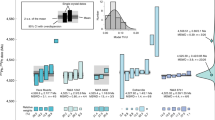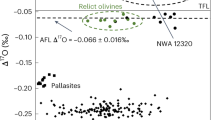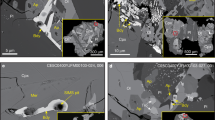Abstract
THE record of collisions on asteroids, as preserved in meteorite breccias, provides important constraints on impact cratering events in the inner Solar System1,2. Many young gas-retention ages (with a peak at ∼500 Myr) have been reported for meteorite breccias3,4, but except for a few cases5, they have not been substantiated by the much less susceptible clocks based on refractory parent-daughter nuclides such as 87Rb–87Sr. Furthermore, the nature and intensity of the thermal events responsible for young meteorite ages have not been well evaluated. Here we report an age of 460±11 (2σ) Myr, well defined by a Rb–Sr internal isochron for the completely impact-melted L-chondrite, Point of Rocks. This age provides the first evidence for a young intense collision leading to melting on an asteroid.
This is a preview of subscription content, access via your institution
Access options
Subscribe to this journal
Receive 51 print issues and online access
$199.00 per year
only $3.90 per issue
Buy this article
- Purchase on Springer Link
- Instant access to full article PDF
Prices may be subject to local taxes which are calculated during checkout
Similar content being viewed by others
References
Chapman, C. R. & Davis, D. R. Science 190, 553–556 (1975).
Roddy, D. J., Pepin, R. O. & Merrill, R. B. (eds) Impact and Explosion Cratering (Pergamon, 1977).
Taylor, G. J. & Heymann, D. Earth planet Sci. Lett. 7, 151–161 (1969).
Bogard, D. D. in Asteroids (ed. Gehrels, T.) 555–578 (University of Arizona Press, 1979).
Nakamura, N. & Okano, O. Nature 315, 563–566 (1985).
Lange, D. E. & Keil, K. Meteoritics 11, 315–315 (1976).
Scott, E. R. D., Maggiore, P., Taylor, G. J., Keil, K. & Szuwalski, D. Lunar planet. Sci. XVII, 785–786 (1986).
Nakamura, N. et al. Analyt. Chem. 61, 755–762 (1989).
Mason, B. (ed.) Handbook of Elemental Abundances in Meteorites (Gordon & Breach, 1971).
Minster, J. F. & Allègre, C. J. Meteoritics 14, 235–248 (1979).
Gray, C. M., Papanastassiou, D. A. & Wasserburg, G. J. Icarus 20, 213–239 (1973).
Turner, G. in Meteorites and the Early Solar System (eds Kerridge, J. F. & Matthews, M. S.) 276–288 (University of Arizona Press, 1988).
Schultz, L. & Signer, P. Earth planet. Sci. Lett. 36, 363–371 (1977).
Author information
Authors and Affiliations
Rights and permissions
About this article
Cite this article
Nakamura, N., Fujiwara, T. & Nohda, S. Young asteroid melting event indicated by Rb–Sr dating of the Point of Rocks meteorite. Nature 345, 51–52 (1990). https://doi.org/10.1038/345051a0
Received:
Accepted:
Issue Date:
DOI: https://doi.org/10.1038/345051a0
Comments
By submitting a comment you agree to abide by our Terms and Community Guidelines. If you find something abusive or that does not comply with our terms or guidelines please flag it as inappropriate.



